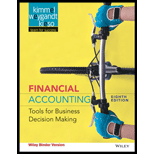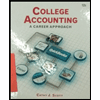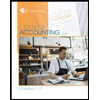
Financial Accounting 8th Edition
8th Edition
ISBN: 9781119210818
Author: Kimmel, Weygandt, Kieso
Publisher: WILEY
expand_more
expand_more
format_list_bulleted
Question
Chapter 10, Problem 10.1BDIE
(a)
To determine
Salaries and wages payable
Salaries and wages payable is a payment made to an employee for completion of work allocated by the company. Gross pay is computed by using normal hours worked by the employee with hourly wages rate.
Payroll tax
The costs incurred by an employer to pay the employee for his labor, including other employee benefits, plus the payroll taxes the employer pays to the government, are called payroll tax.
To prepare: The
(b)
To determine
To prepare: The journal entry to record the payroll taxes as on 28th February.
Expert Solution & Answer
Want to see the full answer?
Check out a sample textbook solution
Students have asked these similar questions
13
Which of the following is correct about the difference between basic earnings per share (EPS) and diluted earnings per share?
Question 13 options:
Basic EPS uses comprehensive income in its calculation, whereas diluted EPS does not.
Basic EPS is not a required disclosure, whereas diluted EPS is required disclosure.
Basic EPS uses total common shares outstanding, whereas diluted EPS uses the weighted-average number of common shares.
Basic EPS is not adjusted for the potential dilutive effects of complex financial structures, whereas diluted EPS is adjusted.
Please explain the solution to this general accounting problem with accurate explanations.
I need guidance with this financial accounting problem using the right financial principles.
Chapter 10 Solutions
Financial Accounting 8th Edition
Ch. 10 - Prob. 1QCh. 10 - Prob. 2QCh. 10 - Prob. 3QCh. 10 - Prob. 4QCh. 10 - Prob. 5QCh. 10 - (a) Identify three taxes commonly paid by...Ch. 10 - Prob. 7QCh. 10 - Prob. 8QCh. 10 - Contrast these types of bonds: (a) Secured and...Ch. 10 - Prob. 10Q
Ch. 10 - Prob. 11QCh. 10 - Prob. 12QCh. 10 - Prob. 13QCh. 10 - Lee and Jay are discussing how the market price of...Ch. 10 - Prob. 15QCh. 10 - Prob. 16QCh. 10 - Prob. 17QCh. 10 - Prob. 18QCh. 10 - Prob. 19QCh. 10 - Prob. 20QCh. 10 - Prob. 21QCh. 10 - Prob. 22QCh. 10 - Prob. 23QCh. 10 - Prob. 24QCh. 10 - Prob. 25QCh. 10 - Prob. 26QCh. 10 - Prob. 27QCh. 10 - Prob. 28QCh. 10 - Prob. 29QCh. 10 - Prob. 30QCh. 10 - Prob. 31QCh. 10 - Prob. 10.1BECh. 10 - Prob. 10.2BECh. 10 - Prob. 10.3BECh. 10 - Prob. 10.4BECh. 10 - Prob. 10.5BECh. 10 - Prob. 10.6BECh. 10 - Prob. 10.7BECh. 10 - Prob. 10.8BECh. 10 - Prob. 10.9BECh. 10 - Prob. 10.10BECh. 10 - Prob. 10.11BECh. 10 - Prob. 10.12BECh. 10 - Prob. 10.13BECh. 10 - Prob. 10.14BECh. 10 - Prob. 10.15BECh. 10 - Prob. 10.16BECh. 10 - Prob. 10.17BECh. 10 - Prob. 10.18BECh. 10 - Prob. 10.19BECh. 10 - Prob. 10.1ADIECh. 10 - Prob. 10.1BDIECh. 10 - State whether each of the following statements is...Ch. 10 - Prob. 10.3ADIECh. 10 - Prob. 10.3BDIECh. 10 - Prob. 10.4DIECh. 10 - Prob. 10.1ECh. 10 - Prob. 10.2ECh. 10 - Prob. 10.3ECh. 10 - Prob. 10.4ECh. 10 - Prob. 10.5ECh. 10 - Prob. 10.6ECh. 10 - Prob. 10.7ECh. 10 - Prob. 10.8ECh. 10 - Prob. 10.9ECh. 10 - Prob. 10.10ECh. 10 - Prob. 10.11ECh. 10 - Prob. 10.12ECh. 10 - Prob. 10.13ECh. 10 - Prob. 10.14ECh. 10 - Prob. 10.15ECh. 10 - Prob. 10.16ECh. 10 - Prob. 10.17ECh. 10 - Prob. 10.18ECh. 10 - Prob. 10.19ECh. 10 - Prob. 10.20ECh. 10 - Prob. 10.21ECh. 10 - Prob. 10.22ECh. 10 - Prob. 10.23ECh. 10 - Prob. 10.24ECh. 10 - Prob. 10.25ECh. 10 - Prob. 10.1APCh. 10 - Prob. 10.2APCh. 10 - Prob. 10.3APCh. 10 - Prob. 10.4APCh. 10 - Prob. 10.5APCh. 10 - Prob. 10.6APCh. 10 - Prob. 10.7APCh. 10 - Prob. 10.8APCh. 10 - Prob. 10.9APCh. 10 - Prob. 10.10APCh. 10 - Prob. 10.11APCh. 10 - Prob. 10.12APCh. 10 - Prob. 10.13APCh. 10 - Prob. 10.1CACRCh. 10 - Prob. 10.1EYCTCh. 10 - Prob. 10.2EYCTCh. 10 - Prob. 10.3EYCTCh. 10 - Prob. 10.4EYCTCh. 10 - Prob. 10.5EYCTCh. 10 - DECISION-MAKING ACROSS THE ORGANIZATION On January...Ch. 10 - Prob. 10.9EYCTCh. 10 - Prob. 10.10EYCTCh. 10 - Prob. 10.14EYCTCh. 10 - Prob. 10.1IFRSECh. 10 - Prob. 10.2IFRSECh. 10 - Prob. 10.3IFRSECh. 10 - Prob. 10.4IFRSE
Knowledge Booster
Similar questions
- General Accounting Question Solutionarrow_forwardWhich is not an objective of internal controls?A. Safeguard assetsB. Improve profitsC. Ensure accurate recordsD. Promote operational efficiencyarrow_forwardI need help finding the accurate solution to this general accounting problem with valid methods.arrow_forward
- Nelson and Murdock, a law firm, sells $8,000,000 of four-year, 8% bonds priced to yield 6.6%. The bonds are dated January 1, 2026, but due to some regulatory hurdles are not issued until March 1, 2026. Interest is payable on January 1 and July 1 each year. The bonds sell for $8,388,175 plus accrued interest. In mid-June, Nelson and Murdock earns an unusually large fee of $11,000,000 for one of its cases. They use part of the proceeds to buy back the bonds in the open market on July 1, 2026 after the interest payment has been made. Nelson and Murdock pays a total of $8,456,234 to reacquire the bonds and retires them. Required1. The issuance of the bonds—assume that Nelson and Murdock has adopted a policy of crediting interest expense for the accrued interest on the date of sale.2. Payment of interest and related amortization on July 1, 2026.3. Reacquisition and retirement of the bonds. Question 20 options: Paragrapharrow_forwardNelson and Murdock, a law firm, sells $8,000,000 of four-year, 8% bonds priced to yield 6.6%. The bonds are dated January 1, 2026, but due to some regulatory hurdles are not issued until March 1, 2026. Interest is payable on January 1 and July 1 each year. The bonds sell for $8,388,175 plus accrued interest. In mid-June, Nelson and Murdock earns an unusually large fee of $11,000,000 for one of its cases. They use part of the proceeds to buy back the bonds in the open market on July 1, 2026 after the interest payment has been made. Nelson and Murdock pays a total of $8,456,234 to reacquire the bonds and retires them. Required1. The issuance of the bonds—assume that Nelson and Murdock has adopted a policy of crediting interest expense for the accrued interest on the date of sale.2. Payment of interest and related amortization on July 1, 2026.3. Reacquisition and retirement of the bonds. Question 20 options: Paragrapharrow_forward11 Which statement is correct about accounting for financial instruments? Question 11 options: All financial instruments are accounted for at fair value through OCI. All financial instruments are accounted for at amortized cost. All are accounted for in accordance to their economic substance. All financial instruments are accounted for at fair value through profit or loss.arrow_forward
- Which of the following is correct about the difference between basic earnings per share (EPS) and diluted earnings per share? Question 13 options: Basic EPS uses comprehensive income in its calculation, whereas diluted EPS does not. Basic EPS is not a required disclosure, whereas diluted EPS is required disclosure. Basic EPS uses total common shares outstanding, whereas diluted EPS uses the weighted-average number of common shares. Basic EPS is not adjusted for the potential dilutive effects of complex financial structures, whereas diluted EPS is adjusted.arrow_forwardI need help Which entry is correct for recording revenue earned on account?A. Debit Cash, Credit RevenueB. Debit Revenue, Credit Accounts ReceivableC. Debit Accounts Receivable, Credit RevenueD. Debit Unearned Revenue, Credit Casharrow_forwardCan you solve this financial accounting problem using appropriate financial principles?arrow_forward
- 5 What are "zero-coupon bonds"? Question 5 options: Bonds that are sold at a premium. Bonds that are unsecured. Bonds that do not pay interest. Bonds that pay the market rate of interest.arrow_forwardWhich statement is correct about accounting for financial instruments? Question 11 options: All financial instruments are accounted for at fair value through OCI. All financial instruments are accounted for at amortized cost. All are accounted for in accordance to their economic substance. All financial instruments are accounted for at fair value through profit or loss.arrow_forward14 Which statement is correct about "weighted average number of ordinary shares outstanding"? Question 14 options: Treasury shares that are not cancelled are adjusted in this calculation. Treasury shares that are cancelled are adjusted in this calculation. Treasury shares that are repurchased are adjusted in this calculation. Treasury shares are ignored for purposes of this calculation.arrow_forward
arrow_back_ios
SEE MORE QUESTIONS
arrow_forward_ios
Recommended textbooks for you
 College Accounting (Book Only): A Career ApproachAccountingISBN:9781337280570Author:Scott, Cathy J.Publisher:South-Western College Pub
College Accounting (Book Only): A Career ApproachAccountingISBN:9781337280570Author:Scott, Cathy J.Publisher:South-Western College Pub College Accounting (Book Only): A Career ApproachAccountingISBN:9781305084087Author:Cathy J. ScottPublisher:Cengage Learning
College Accounting (Book Only): A Career ApproachAccountingISBN:9781305084087Author:Cathy J. ScottPublisher:Cengage Learning Intermediate Accounting: Reporting And AnalysisAccountingISBN:9781337788281Author:James M. Wahlen, Jefferson P. Jones, Donald PagachPublisher:Cengage Learning
Intermediate Accounting: Reporting And AnalysisAccountingISBN:9781337788281Author:James M. Wahlen, Jefferson P. Jones, Donald PagachPublisher:Cengage Learning- Century 21 Accounting Multicolumn JournalAccountingISBN:9781337679503Author:GilbertsonPublisher:Cengage
 College Accounting, Chapters 1-27 (New in Account...AccountingISBN:9781305666160Author:James A. Heintz, Robert W. ParryPublisher:Cengage Learning
College Accounting, Chapters 1-27 (New in Account...AccountingISBN:9781305666160Author:James A. Heintz, Robert W. ParryPublisher:Cengage Learning College Accounting, Chapters 1-27AccountingISBN:9781337794756Author:HEINTZ, James A.Publisher:Cengage Learning,
College Accounting, Chapters 1-27AccountingISBN:9781337794756Author:HEINTZ, James A.Publisher:Cengage Learning,

College Accounting (Book Only): A Career Approach
Accounting
ISBN:9781337280570
Author:Scott, Cathy J.
Publisher:South-Western College Pub

College Accounting (Book Only): A Career Approach
Accounting
ISBN:9781305084087
Author:Cathy J. Scott
Publisher:Cengage Learning

Intermediate Accounting: Reporting And Analysis
Accounting
ISBN:9781337788281
Author:James M. Wahlen, Jefferson P. Jones, Donald Pagach
Publisher:Cengage Learning

Century 21 Accounting Multicolumn Journal
Accounting
ISBN:9781337679503
Author:Gilbertson
Publisher:Cengage

College Accounting, Chapters 1-27 (New in Account...
Accounting
ISBN:9781305666160
Author:James A. Heintz, Robert W. Parry
Publisher:Cengage Learning

College Accounting, Chapters 1-27
Accounting
ISBN:9781337794756
Author:HEINTZ, James A.
Publisher:Cengage Learning,